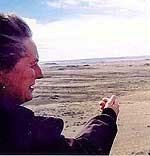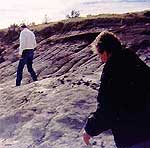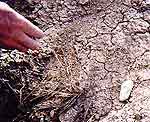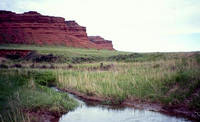By Josh Welsh
South Dakota Public Radio
March 11, 2002
|
|
RealAudio |
The Dakota, Minnesota and Eastern Railroad's expansion plan takes the DM&E into the Powder River Basin coal fields, and requires more than 250 miles of new track in western South Dakota and eastern Wyoming.
Opponents have sprung up along that new section of railway. They are ranchers concerned about tracks cutting through their land, and Native Americans who say the project will trample all over treaty rights. Another point of opposition may be found just under the surface of the ground.
| |
|
|
|
||
Driving down the west slope of the Black Hills towards Newcastle, Wyo., the prairie stretches out below, and it's easy to imagine that the land has looked the same forever. But Nancy Darnell, who ranches just south of Newcastle, says millions of years ago, the parched earth here looked very different.
"What we had here was an inland sea, and this was the mouth of the inland sea as it came around the edge of the Black Hills, and so we have the marine fossils," Darnell says. "As we rise up here, this was actually the seashore. And over to the west, that ground is even higher, and there's a lot of dinosaurs."
Darnell says the new track the DM&E wants to build would cut right through an area rich in dinosaur fossils. The Federal Surface Transportation Board, an agency that monitors railroad projects, has approved this project. Darnell says neither the railroad nor the STB have done enough study on the paleontological resources of the region.
Others are concerned about archeological sites along the route as well. Leola One Feather helped keep tabs on the railroad survey for the Oglala Sioux Tribe. She says anywhere the railroad goes, you could probably find archeological sites just a few feet underground.
| |
|
|
|
||
"All of the Black Hills are burial grounds. We put our people into scaffolds, and when the buffalo hide rotted and the braces started to give, there was always a return to those sites to re-inter the remains," One Feather says. "Where they would re-wrap the human bones, and they made bundles, and put them in the ground or different places."
Recently, One Feather walked part of the route the new tracks would take. She found plenty of evidence the region is rich with artifacts - arrowheads that could date back 6,000 years, and cairns, circles of rocks left as a landmark or a fire ring. One Feather says some burial sites can be found within a mile of the proposed route.
"We have to protect our burial grounds. It would be like - say if you died, what guarantee do you have that in a hundred years, somebody's not going to want to put a road right where you're at," she says.
One Feather isn't the only one worried about Native American graves along the route. Another expansion opponent is Charmaine White Face, a member of the Oglala Sioux Tribe. She says the new track would go through the site of a little-known massacre of some 50 Indians along the Cheyenne River.
| |
|
|
|
||
"They were on a hunting party. They went to this rancher, he told them, 'You better go back across the Cheyenne River,' because there was - I would call them marauders - out looking to kill Indian people," White Face recalls. "They had been traveling all day, and so when they turned around to go back, they got as far as French Creek. And they camped there and they were ambushed early the next morning, and over 50 people were killed."
White Face says only one woman survived that massacre in 1890. It came just three weeks before the infamous Wounded Knee Massacre. White Face says the area should remain undisturbed, so that Native Americans can go there to pray. And she says the federal government should have done a more complete archeological study of the route.
The head of the Surface Transportation Board, Linda Morgan, admits without a shovel dig, it's impossible to identify all the archeological sites that could be affected by a project this big. But Morgan says the STB is requiring the railroad to agree to protect the sites it finds during construction.
"This agreement and plan provides for more surveying of the property, and - once identifying certain sites - what you do about that, and how you go about preserving that sites," Morgan says.
| |
|
|
|
||
But Charmaine White Face says the DM&E railroad already has a bad track record when it comes to protecting archeological sites. She points to the Price Site - an archeological dig near Mankato, Minn. - as an example. An anthropologist from Minnesota State University had been studying the site for years. But in 1998, the site was dug up by a DM&E crew. They used the soil as fill for work on a nearby railroad bridge. White Face says the anthropologist was shocked at the damage.
"When you're working on a site, they're staked off. They very meticulously started sifting through every piece, every grain of sand," White Face says. "His students told him that gravel was missing at the site. He went out there, and there are pictures that show the Price Site was bulldozed into a bridge landfill by DM&E railroad."
White Face worries the DM&E will be even less careful protecting undiscovered artifacts. But DM&E President Kevin Schieffer says the work at the Price Site was done properly.
"We actually received a permit, and someone after the fact raised a concern," says Scheiffer. "If someone wants to produce some evidence that there was an issue, I guess I would be happy to address it, but we've...got a very good record in that regard."
| |
|
|
|
||
Schieffer says the DM&E has already spent more than $1 million on archeological surveys for the new route in South Dakota. He agrees the construction is bound to upset archeological sites. But he says the railroad will take those impacts seriously.
"I think we have developed a program where we will actually be able to add scientific benefit to the archeological community, because we've agreed to do the science, the excavation and the curation of any archeological findings that we come through out there," says Scheiffer. "There's a lot of work that will be done, and I think we've got a very good agreement on that issue."
Once heavy machinery starts to dig, it's not clear who will make sure the railroad actually does protect important archeological findings.
Lawsuits against the expansion are gaining momentum. The Mid-States Coalition, a group of landowners, has already filed suit against the Surface Transportation Board. They say in making its decision, the federal government didn't consider all the environmental consequences, such as Native American grave sites. Those sites could be at the heart of their case.
More from MPRMore Information





